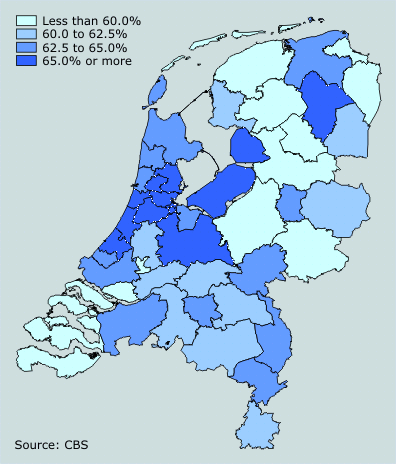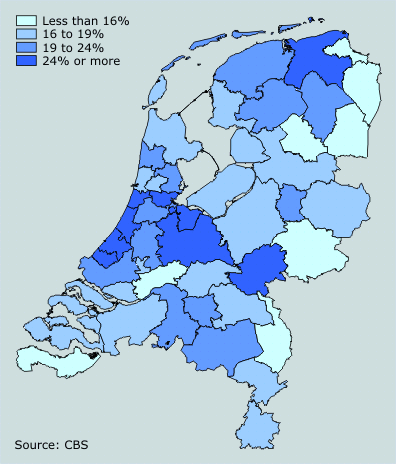Regional variation in female labour supply

There are large regional differences in female labour supply, whereas male labour supply is much more evenly spread across the country. In the period 2002/2004, there was a 15 percentage points gap between the top and bottom values indicating female labour supply. There is a strong link between labour supply and age and education level. After correction for these determinants, regional differences, though reduced, still remain considerable.
Female labour supply lower in rural areas
In the period 2002/2004, over 63 percent of women in the 15-64 age bracket belonged to the labour supply. Regional differences in female labour supply ranged from 55 percent in COROP area Other Groot-Rijnmond to 70 percent in Amsterdam. The following (rural) regions scored below average: Veluwe, the province of Zeeland and one or more COROP areas in the provinces of Drenthe, Friesland, Groningen, and Overijssel.
Female labour supply by (sub)COROP area, 2002/2004

Lower supply of labour in regions with a high proportion of older people
Young and older women are less active on the labour market. Indeed, regions with a comparatively large young or older population usually have a low female labour supply. Large parts of the provinces of Groningen, Friesland, Drenthe, Zeeland and Limburg, for instance, have considerable numbers of older residents. In urban regions like Greater Amsterdam and The Hague, the labour supply of women in the 50-64 age category was above average.
Many highly-educated women in the Randstad area
Labour supply among highly-educated women, i.e. women who have completed a vocational college or university education, is 84 percent above the nationwide average. COROP areas with comparatively many highly-educated female residents are mainly found in the provinces of North and South Holland and in university towns like Utrecht, Nijmegen and Groningen.
The Greater Amsterdam and The Hague regions have many highly-educated women as well as a female labour supply above average (87 percent in both regions).
Share of highly-educated women by (sub)COROP area, 2002/2004

Large regional differences after correction for age and education level
Correction for age and education level results in a change in labour supply by more than 2.5 percentage points in 7 of the 43 (sub)COROP areas. In Amsterdam, correction for age and education level leads to a decrease in labour supply by 6 percentage points, due to overrepresentation of young and highly-educated people. Conversely, labour supply increases after correction for age and education level in areas with many older residents. Yet differences between the various regions remain large. After correction, female labour supply ranges between 57 and 67 percent. COROP area Other Groot-Rijnmond remains the region with the lowest labour supply, whereas the highest labour supply after correction for age and education level is recorded in Other Greater Amsterdam.
Female labour supply by (sub)COROP area, adjusted for age and education level, 2002/2004

Hendrika Lautenbach